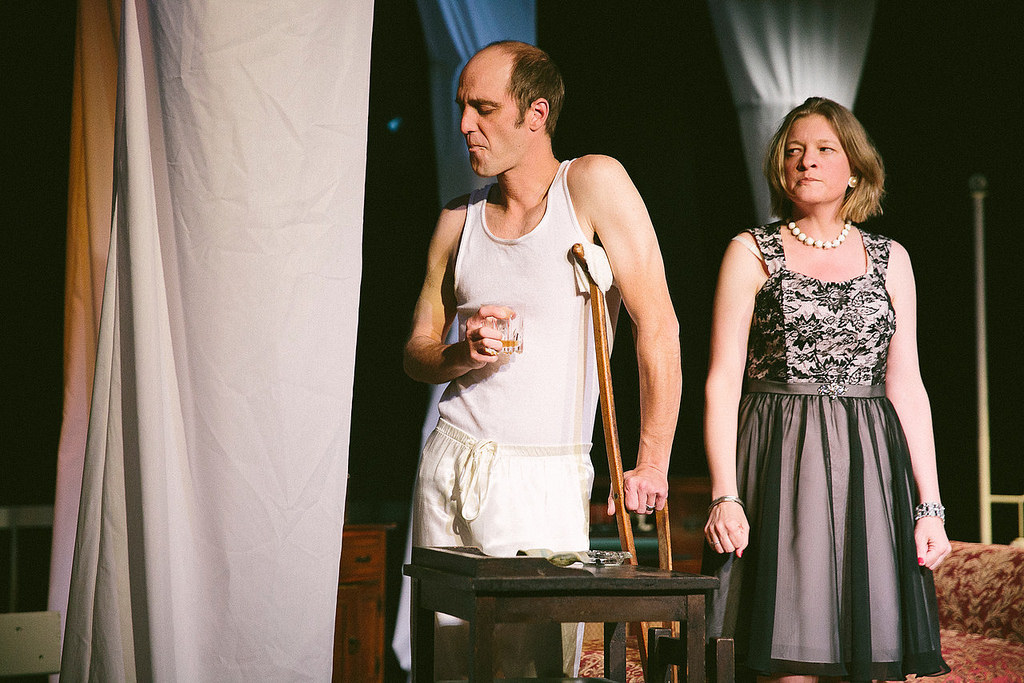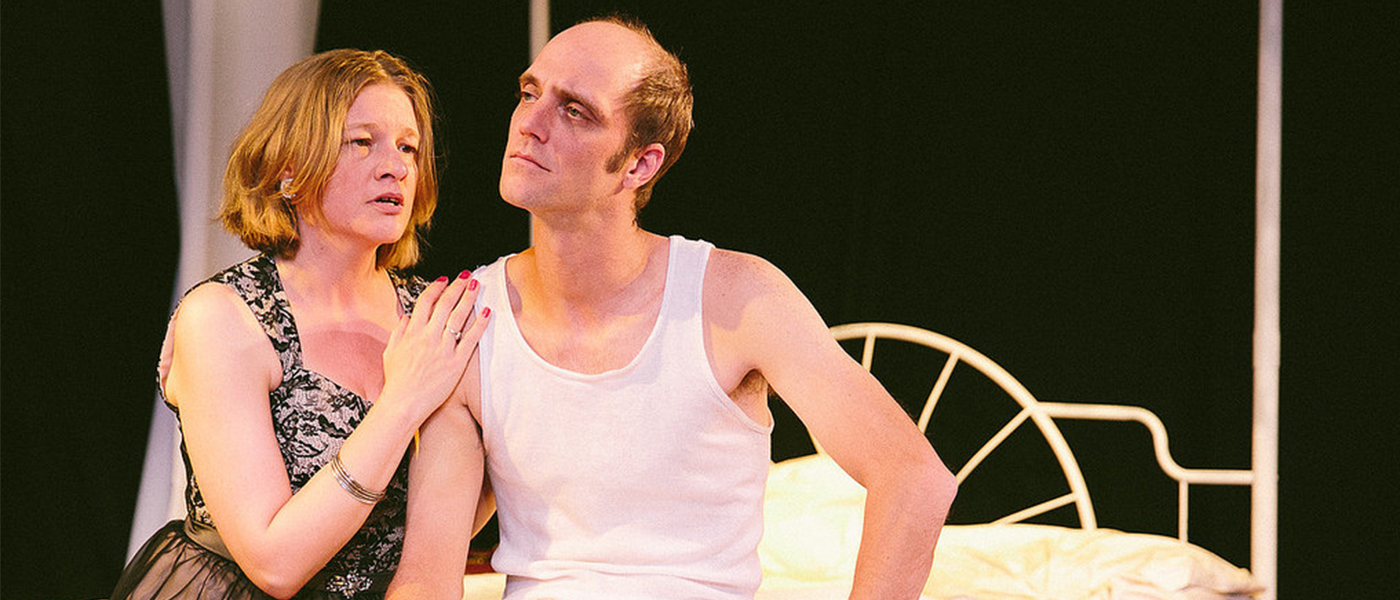While A Streetcar Named Desire might conventionally be pegged as Tennessee Williams’ top play, the playwright himself always ranked Cat on a Hot Tin Roof higher, and with good reason.
All the great dramas are family stories, and this one centers on the imminent death of a powerful patriarch, Big Daddy, whom we are prepared to loathe but who luxuriates in some of the most dazzling dialogue Williams ever wrote. Streetcar’s Blanche might be one of the few genuinely tragic figures of the American stage, but Cat’s Maggie offers a bigger, more variable role.
 Both the leading lady’s appearance and the production design for Cat on a Hot Tin Roof are departures from recent Central New York Playhouse fare. Director and set designer Roy Van Norstrand, assisted by scenic artist Morgan O’Donnell Curry, has emphasized open space. All action might be in Maggie and Brick’s bedroom, with the empty bed at center, but upstage and to stage right are translucent scrims through which we can see who’s coming to the door and who’s eavesdropping on the belvedere or porch. Tall, white columns of muslin remind us that this is the Mississippi Delta in 1955, before air conditioning.
Actress Heather Roach has been a utility infielder for Central New York Playhouse, taking a variety of roles yet never hogging the spotlight. Here she is thinner, more glamorous and, well, kittenish. Maggie’s opening monologue, one of the longest in American drama, glosses the meaning of the title along with outlining all the shenanigans roiling the household of Brick’s family.
Everyone is lying about Big Daddy’s fatal prognosis, and Brick’s weak brother Gooper (Jay Merante) and his grasping wife Mae (Erin Williamson) are plotting to take over the estate. Meanwhile, Maggie mourns her unused marriage bed as Brick has been ignoring her sexually.
Cast even more sharply against type is Josh Taylor’s Brick. Thin and balding, Taylor is best known for comic roles, like Igor in Baldwinsville Theatre Guild’s Young Frankenstein or 15 pop-up parts in Spamalot. Keeping your face busy might be good for laughs, but it is also what Brick needs for extensive hostile listening. Taylor’s Brick, a wounded and unmanned warrior, contributes to dialogue without speaking. He is also prepared to roar when confronting Big Daddy with the truth everyone’s been so mendacious about.
Tom Minion has been in demand for some time, usually as sympathetic characters, like the mournful C.S. Lewis in Shadowlands. We have also thought of him as a fairly trim fellow, but for Cat he has come up with a useful, protruding belly (perhaps a prosthetic?).
The belly reminds us that Big Daddy, one of Williams’ most startling creations, is part bully, part Falstaff. He might be crude and insensitive, but his orations on the worthlessness of material goods unmistakably speak for the playwright. Minion, who is credited as co-director, has put his belly and his soul into this portrayal.
While director Van Norstrand might have a taken a chance casting his leads against type, he turns to two reliable players in supporting roles. Anne Fitzgerald, tricked out in a Virginia Graham big-hair gray wig, is the Big Momma that would drive any son to drink, broken leg or not. In a smaller role, Erin Williamson’s Mae, visibly pregnant and anything but motherly, is more than a one-note villainess.
Both the leading lady’s appearance and the production design for Cat on a Hot Tin Roof are departures from recent Central New York Playhouse fare. Director and set designer Roy Van Norstrand, assisted by scenic artist Morgan O’Donnell Curry, has emphasized open space. All action might be in Maggie and Brick’s bedroom, with the empty bed at center, but upstage and to stage right are translucent scrims through which we can see who’s coming to the door and who’s eavesdropping on the belvedere or porch. Tall, white columns of muslin remind us that this is the Mississippi Delta in 1955, before air conditioning.
Actress Heather Roach has been a utility infielder for Central New York Playhouse, taking a variety of roles yet never hogging the spotlight. Here she is thinner, more glamorous and, well, kittenish. Maggie’s opening monologue, one of the longest in American drama, glosses the meaning of the title along with outlining all the shenanigans roiling the household of Brick’s family.
Everyone is lying about Big Daddy’s fatal prognosis, and Brick’s weak brother Gooper (Jay Merante) and his grasping wife Mae (Erin Williamson) are plotting to take over the estate. Meanwhile, Maggie mourns her unused marriage bed as Brick has been ignoring her sexually.
Cast even more sharply against type is Josh Taylor’s Brick. Thin and balding, Taylor is best known for comic roles, like Igor in Baldwinsville Theatre Guild’s Young Frankenstein or 15 pop-up parts in Spamalot. Keeping your face busy might be good for laughs, but it is also what Brick needs for extensive hostile listening. Taylor’s Brick, a wounded and unmanned warrior, contributes to dialogue without speaking. He is also prepared to roar when confronting Big Daddy with the truth everyone’s been so mendacious about.
Tom Minion has been in demand for some time, usually as sympathetic characters, like the mournful C.S. Lewis in Shadowlands. We have also thought of him as a fairly trim fellow, but for Cat he has come up with a useful, protruding belly (perhaps a prosthetic?).
The belly reminds us that Big Daddy, one of Williams’ most startling creations, is part bully, part Falstaff. He might be crude and insensitive, but his orations on the worthlessness of material goods unmistakably speak for the playwright. Minion, who is credited as co-director, has put his belly and his soul into this portrayal.
While director Van Norstrand might have a taken a chance casting his leads against type, he turns to two reliable players in supporting roles. Anne Fitzgerald, tricked out in a Virginia Graham big-hair gray wig, is the Big Momma that would drive any son to drink, broken leg or not. In a smaller role, Erin Williamson’s Mae, visibly pregnant and anything but motherly, is more than a one-note villainess.


Gooper (Jay Merante, left) and his wife Mae (Erin Williamson, right) in Cat on a Hot Tin Roof.
Photo by Amelia Beamish










